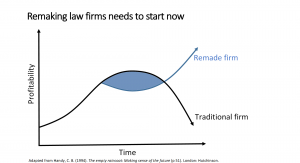First steps in remaking a BigLaw firm
In his Foreword to Remaking Law Firms: Why & How Eduardo Leite, Chairman of the Executive Committee of Baker & McKenzie writes “There was a time when we mostly worried about advising clients and billing time. Today, we deal with disruptive technologies, commoditization, unbundling of legal services, globalization of firms, BigLaw and NewLaw, and co-opetition…And he goes on to write “… as chief change agent for one of the world’s largest law firms, I am constantly looking for insights to help us make sense of change, and to make those changes necessary for us to remain one of the world’s leading law firms.”
Mr Leite captures the formidable challenge of what all law firms – from those with five lawyers in the suburbs to those with 5,000 lawyers spanning the globe – must do: Change.
To grasp why the requisite change is so deep and fundamental, it’s essential to understand the business model of the traditional law firm, i.e. how the firm serves clients and makes money. And why this business model is starting to reach its use-by date.
Peter Drucker, famous for many business aphorisms, wrote “What underlies the malaise of so many large and successful organizations worldwide is that their theory of the business no longer works.”
Today we understand ‘theory of business’ means business model and the business model of a law firm needs to articulate how work is won, how work is done, and how the enterprise is governed. Remaking a traditional law firm means designing its business model to move towards the more client-centric, more efficient, and more agile hallmarks of the NewLaw business model.
Larger firms can consist of two or more different business models, for example through an ownership stake in captives or legal start-ups, through sourcing from NewLaw providers, by providing on-demand legal talent agencies, and/or by offering commoditized online services.
Examples of these dual models in Australia are in the embryonic stage, but encouragingly Corrs Chambers Westgarth with Orbit, McInnes Wilson with Lexvoco, Minter Ellison with Flex and Gilbert & Tobin’s investment in LegalVision all point in the right direction, as does the DLA Piper–LOD alliance and the Norton Rose Fulbright–LawPath alliance. This list is not exhaustive and does not include the growing number of start-ups like View Legal, Hive Legal and many more.
First steps in remaking a BigLaw firm: Readiness for change
As several of the reviewers of Remaking Law Firms have already noted, one of the book’s most significant contributions is to argue that the core competence of change readiness and change management are probably the most crucial elements of what’s require for a firm to ‘remake’ itself successfully.
Law firm partnerships are well known for being amongst the most conservative and hard-to-change organisational forms. When the lack of a real balance sheet is combined with almost everyone working in the business focused on serving clients and incentives that reward short-run profitability, it’s not surprising that the legal profession is trailing others. Lawyers tend to be conservative and risk-averse in their personality traits, and their quest for perfection is at odds with the experimental approach that sees failure as necessary part of development and change in organisations.
 Charles Handy’s famous S-curve, shown in the schematic diagram in a contemporary legal services adaptation, explains that the time to start the change journey is when a firm is still on top, and not wait until it has passed its peak and looking down the slope of decline.
Charles Handy’s famous S-curve, shown in the schematic diagram in a contemporary legal services adaptation, explains that the time to start the change journey is when a firm is still on top, and not wait until it has passed its peak and looking down the slope of decline.
This is doubly hard when partners say to their leaders “Look how well we are doing; we’re busy and times are good”.
But the far-sighted recognise there is a burning platform in the legal services market that necessitates transformational, rather than incremental change in law firms. Those firms that intend to remain as successful as they are today in serving clients and making profits must welcome and embrace the disruption that transformational change brings. Innovation—or remaking a BigLaw firm in keeping with the title of this book—needs to be an integral part of a firm’s overall strategy, starting in small ways and including an assessment of the risks involved in building a realistic portfolio of innovation initiatives.
Any change journey needs sustained and consistent leadership in order to create lasting meaningful changes, and to improve overall change readiness and organisational change capability in the process.
No change journey is easy, and BigLaw firms needs to start their journey sooner rather than later.
Author
George Beaton is a partner in beaton and a senior fellow in Melbourne Law School. This three-part series is based on Remaking Law Firms: Why & How, a book co-authored with Imme Kaschner, published by the American Bar Association in March 2016. Remaking Law Firms is available in hard and soft copy from ShopABA on the ABA website.
Acknowledgement
A variation of this post first appeared in The Australian on 22 April, 2016 as part 2 of a series on the imperatives for remaking law firms.



Leave a Reply